All Articles
6 min read
Understand Deep Oscillation® Therapy

Written by
PhysioPod
Published on
August 18, 2024
Deep Oscillation therapy, developed by Physiomed Elektromedizin AG in Germany, is a clinically proven, electrostatic therapy which carries an international patent. This article talks you through how Deep Oscillation therapy works and how it can be beneficial for people with long term health conditions.
If preferred, you can listen to audio of this article by clicking the links below
Questions – 1 to 10
Questions – 11 to 18
Questions – 19 to 21
1. What is Deep Oscillation therapy?
It is administered to the patient through vinyl gloved hands or applicators which also enable self-care. In deep oscillation, an alternating electrostatic field is built up between the tissue of the patient and the hand of the therapist or a hand applicator. When moving over the patient’s skin electrostatic forces alternately pull and release the tissue, which results in a deep resonance vibration that penetrates the patient’s tissue over all tissue components to a depth of 8 cm (image 1: skin, connective tissue, subcutaneous fat, fasciae, muscles, blood and lymph vessels)
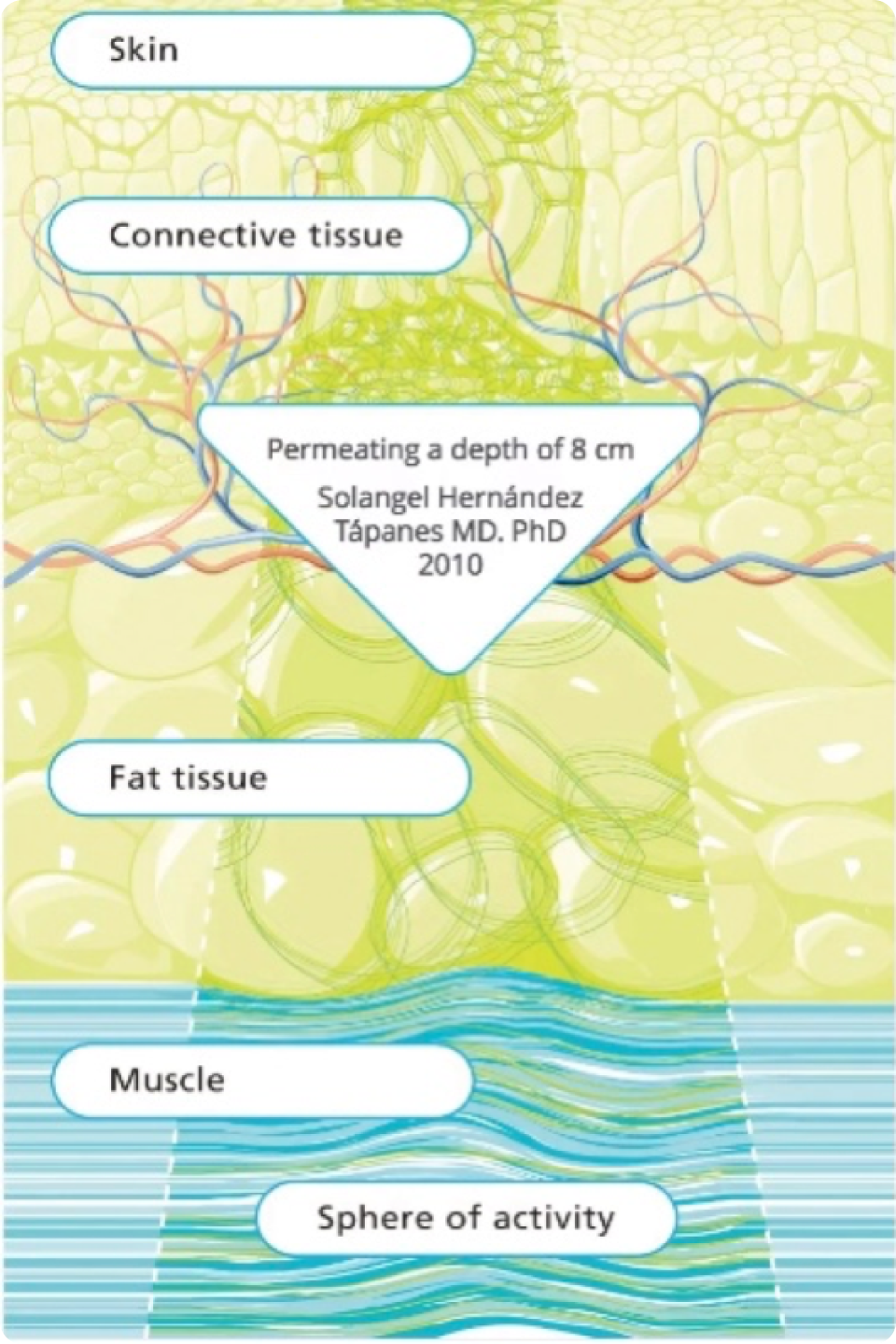
2. What is the sensation of Deep Oscillation?
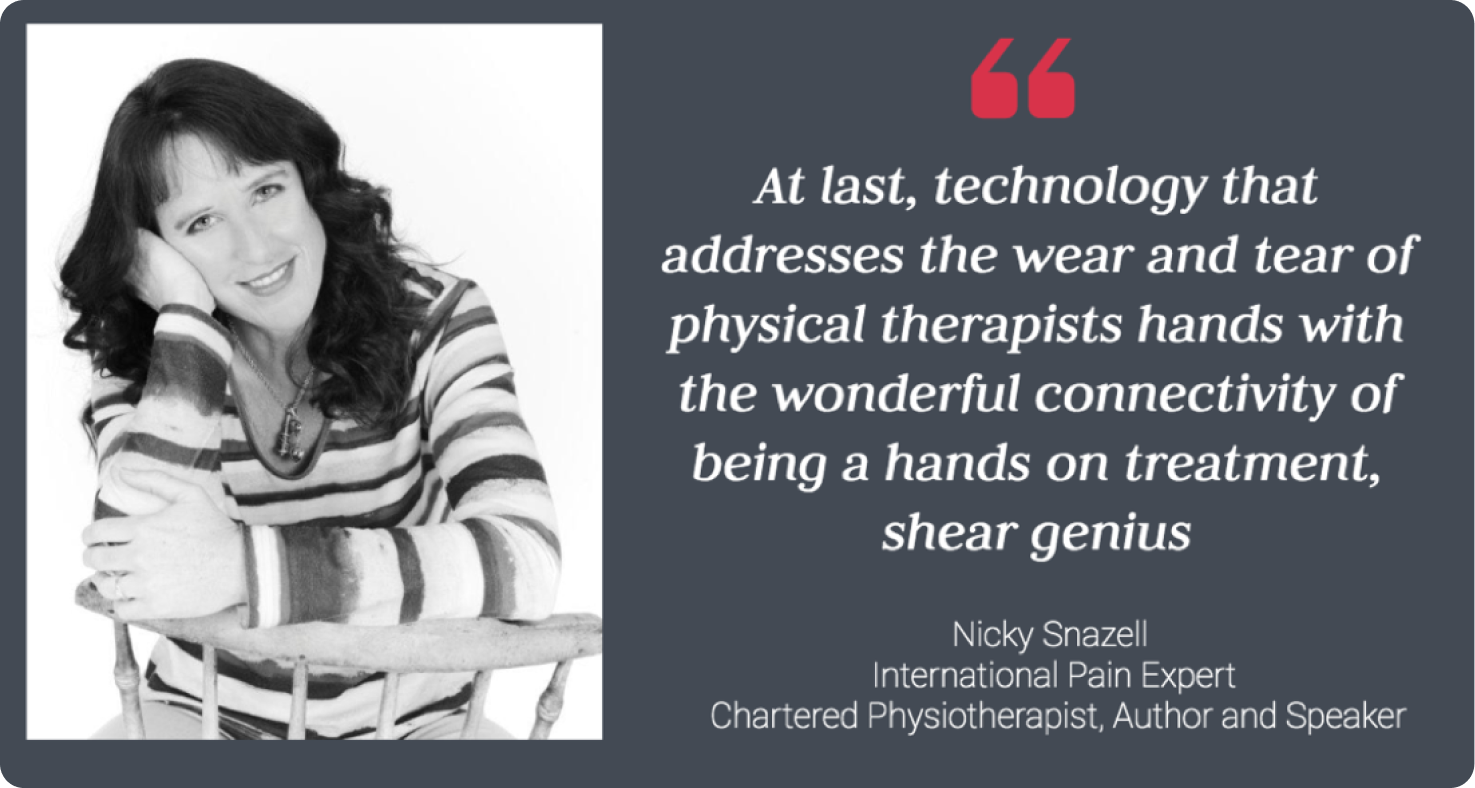
The client experiences a soft, pleasant, deep calming vibration in their tissues. The therapist feels the same soft vibration in their own hands while massaging, without exerting pressure, reducing wear and tear on their hands. Subjectively, many therapists claim that regular use relieves discomfort in their hands, especially osteoarthritic pain and stiffness.
3. What are the Clinical Effects of Deep Oscillation?
- Pain Relief
- Muscle and tissue relaxation
- Increased ROM
- Improves functional mobility and movement
- Decreases swelling and encourages movement of fluids
4. How is Deep Oscillation Applied?
A therapist, partner, or other supportive person can administer Deep Oscillation as a massage via vinyl gloves or they can use special applicators. Both therapist and patient are connected to the unit, the therapist wears an electrode on their arm and the patient holds a titanium bar. Applicators can also be used and these also enable self-treatment. (Please note, you cannot self-treat with gloves).
5. Whereabouts can Deep Oscillation be Applied?
All across the body, including the upper eyelids. (It cannot be used internally).
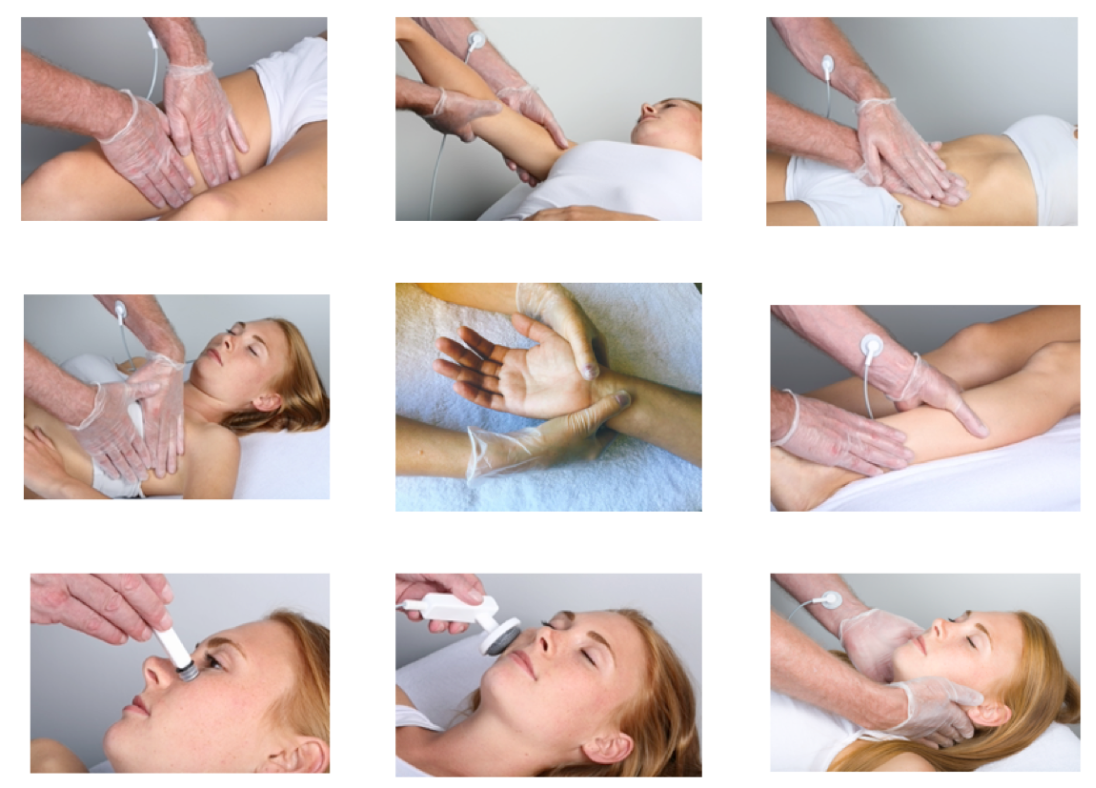
6. Is it Safe to Use Across all Age Groups?
Yes, from babies to the elderly.
7. Are there any Contraindications?
Normal massage contraindications, plus pregnancy and pacemaker.
8. What Units are Available?
Click here to see available units
Deep Oscillation Personal Pro – for patients.
Deep Oscillation Personal Basic – for therapists.
Deep Oscillation Evident in versions clinic, sports or aesthetics – for hospitals and clinics.
9. Who Uses Deep Oscillation?
Many therapists in the United Kingdom and Ireland have now added deep-oscillation therapy to their services. A therapist map on the PhysioPod website indicates if treatment is available in your area.
- Chartered Physiotherapists
- Chiropractors
- Complementary Therapists
- Equine & Canine Therapists
- Lactation Consultants
- MLD Therapists – Private
- MLD Therapists – NHS
- Osteopath
- Private Hospitals
- Scar Therapists
- Sports Therapists
10. How is it Used in Lymphoedema?

Before Head and Neck Lymphoedema, June 2022 and after self-treatment February 2023, with the Deep Oscillation Personal Basic, read full patient testimonial
Complex lymphoedema cases, including head and neck lymphoedema, breast and genital oedema are challenging to treat and distressing for the patient. Deep Oscillation has been a game changer in these areas. Those living with these conditions (and with upper and lower limb lymphoedema) can now also self-treat with the Deep Oscillation Personal Basic unit in the privacy of their own home. The units can also be taken abroad as hand luggage. Deep Oscillation manages cabin pressure and gravity-induced symptom variations. Patients like self-treating as it gives them a feeling of self-control.
11. Can you Name some of the Chronic Health Conditions Listed in the Home Unit?
- Achillodynia (Chronic pain in the Achilles tendon area)
- Arthrosis (Degenerative joint disease)
- COPD (Chronic obstructive pulmonary disease)
- Fibromyalgia (Chronic widespread pain)
- Iliosacral Syndrome (Chronic inflammation or dysfunction in the sacroiliac joint)
- Lymphoedema (Chronic swelling due to lymphatic system issues)
- Myalgia (Chronic muscle pain)
- Parkinson’s Syndrome (Chronic neurological disorder)
- Raynaud’s Syndrome (Chronic condition affecting blood flow)
- Venous Circulatory Disorder (Chronic issues with blood flow in veins)
12. Can it be Useful for Conditions like Chronic Fatigue, Multiple Sclerosis (MS)?
For individuals dealing with chronic fatigue syndromes or conditions like multiple sclerosis (MS), deep oscillation therapy can serve as a supportive treatment to enhance overall well-being. The therapy’s gentle nature allows for its use in situations where other physical therapies may be too intense. Chronic fatigue conditions often have a significant impact on mobility and energy levels, and therapy can help improve circulation and reduce muscle stiffness
13. Can Deep Oscillation be Used for Injuries?
Deep Oscillation is regularly used for acute injury management, trauma or overuse and some of these conditions are listed below:
- Achilles Tendon Rupture (acute injury)
- Epicondylitis (often known as “tennis elbow” or “golfer’s elbow”)
- Haematoma (can be caused by sports trauma)
- Ligament Rupture (acute injuries often relating to sports)
- Muscle Fibre Rupture (also known as a muscle tear, often due to sports)
- Sprain (an injury to ligaments often caused by sporting activities)
- Whiplash Injury (can occur in sports like contact sports or falls, or motor accidents)
14. Why is Deep Oscillation Different to Other Massage Therapies?
Deep oscillation, though applied to the surface of the skin, like other therapies, operates from the inside out, with resonant vibrations facilitating the movement of body fluids and excess biological matter; reducing pain, and swelling and promoting healing in acute and chronic conditions. Tissue layers are attracted and released up to 250 times a second.
15. Can Deep Oscillation be Used over Implanted Metal?
Deep Oscillation can be safely applied over implanted pins and plates because it does not produce any heat.
16. What Makes Deep Oscillation so Special?
The beauty of deep oscillation is its ability to enhance circulation and aid lymphatic drainage. For those with chronic conditions such as lymphoedema, lipoedema, chronic pain syndromes, or fibromyalgia, this can be a critical therapeutic benefit. Improved circulation efficiently delivers oxygen and essential nutrients to tissues, facilitating repair processes. Improvements in lymphatic drainage help remove waste products and reduce fluid retention, which can alleviate swelling and inflammation—common challenges faced by those with chronic health issues
Persistent and sometimes debilitating pain, frequently accompanies chronic conditions, which traditional pain management strategies may not always adequately address. Deep oscillation can interfere with pain signals, helping to provide fast relief and additionally, by promoting the relaxation of tense muscles and reducing inflammation, deep oscillation can further diminish discomfort improving quality of life.
More detailed information on deep oscillation works with pain can be read here, in an article that appeared in MLD UK The Journal written by Dr Jens Reinhold in 2017.
17. Is Deep Oscillation Beneficial Post-Surgical Rehabilitation?
Yes, in post-surgery care, treatment can be implemented in the acute period reducing pain, swelling and bruising, shortening the natural healing process and enabling a quicker return to normal activities.
18. Can Deep Oscillation Help with Burns and Scar Management?
Deep oscillation therapy can play a valuable role in both burn and scar management by promoting healing, reducing inflammation, and improving the appearance and texture of scars. Chronic skin conditions, as well as the surgical interventions that many people with chronic health issues undergo, can lead to significant scarring and fibrosis. Deep oscillation helps to soften and improve scar tissue elasticity through regular treatment, resulting in a more functional and aesthetically pleasing outcome. In burn management, early use of deep oscillation therapy can help in minimizing the formation of scars after burns by promoting normal healing processes and collagen remodelling.
19. How can Deep Oscillation Help Reduce Keloid Scars and Fibrosis?
Yes, Deep oscillation can help in both conditions.
While both keloid scars and fibrosis involve the overproduction of collagen and relate to the body’s healing response, they are different in terms of their nature, characteristics, and locations in the body.
Deep oscillation therapy can reduce keloids’ size and visual appearance by regulating collagen production. Raised keloid scars become less rigid and more pliable, resulting in a softer and flatter appearance. A significant number of keloids result in scar pain or heightened sensitivity. Deep oscillation therapy can soothe nerve terminals and induce relaxation in tissue, resulting in pain relief.
Fibrosis refers to the thickening and scarring of connective tissue, which can occur in various organs and tissues throughout the body. Fibrous connective tissue is often a result of injury, inflammation, or chronic disease.
Deep Oscillation helps to soften the fibrotic tissue, breaking down the dense collagen bundles and making the tissue more pliable. Deep oscillation facilitates collagen remodelling by stimulating local fibroblast activity, which can help balance collagen production restoring the normal architecture of connective tissue. The breakdown of fibrotic connective tissue aids lymphatic drainage and flow.
20. Can you Summarise Deep Oscillation for Chronic Health Conditions?
In summary, deep oscillation therapy offers a gentle yet effective approach to managing chronic conditions. By promoting healing, reducing pain, and enhancing mobility, it serves as a valuable adjunctive therapy that can improve the quality of life for those struggling with the enduring challenges of chronic health issues.
The non-invasive and pain-free nature of deep oscillation makes it a suitable option for those with heightened sensitivity, often characteristic of chronic conditions. Patients who might find traditional massage painful or uncomfortable can tolerate deep oscillation better, as it does not rely on physical pressure but rather on the gentleness of induced oscillations.
21. Are there any Other Areas that Deep Oscillation can Help with?
Anti-aging, dark circles under eyes, eye bags, swollen eye lids and grades I and II cellulite.
About PhysioPod® UK Limited
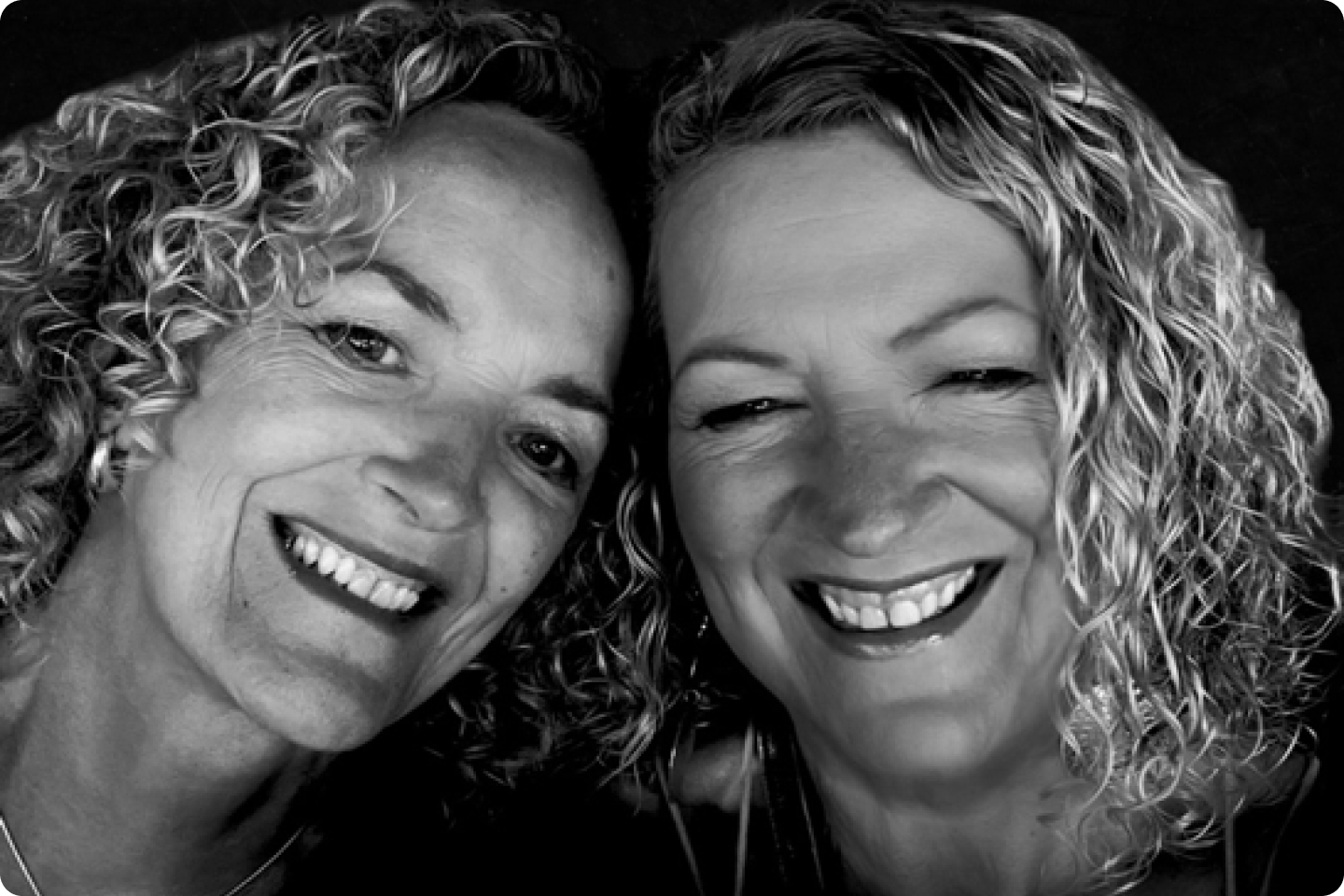
Julie Soroczyn and Mary Fickling, two sisters introduced the previously unknown therapy to the United Kingdom and Ireland in 2007. They supervise and operate PhysioPod® UK Ltd., the exclusive distributor for the region. In 2012, they were certified as suppliers by the NHS and are recommended by the Acupuncture Association of Chartered Physiotherapists (AACP). To obtain information regarding the range of products available for both personal and professional use, please reach out to PhysioPod®:
Contact Information
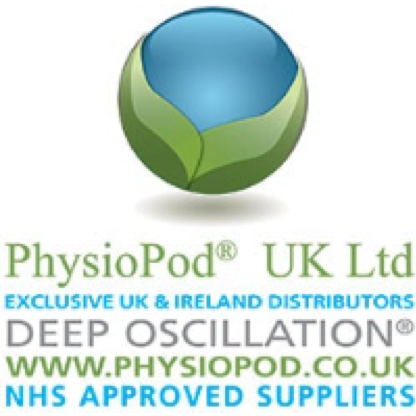
PhysioPod UK Limited
Website – www.physiopod.co.uk
Email – [email protected]
Phone – 0115 9167685
Mobile – 07886925715
Related Articles
The Healing Touch of Acupuncture
Prioritising Health: A Health Screening Experience at Randox Health
Empowering Products for Chronic Illnesses and Disabilities

